Oppressive, Parasitic Workings of Capitalism-Imperialism Continue Needless COVID-19 Horrors
Part 1
| revcom.us
A number of articles posted previously at revcom.us1 have exposed how the workings of capitalism-imperialism have led to needless horrors under the COVID-19 pandemic:
- Production of PPE (personal protection equipment) was subject to the workings of global supply chains in a lopsided world of rich capitalist-imperialist countries and poor countries—where much of PPE was made in Third World sweatshops where workers are subjected to oppressive conditions;
- The U.S., Britain, Europe and other imperialist powers funded pharmaceutical companies to develop vaccines, but instead of pooling efforts and sharing knowledge, these countries competed with each other to gain economic, political and strategic advantage, to make sure their country got vaccinated first;
- The U.S. and other rich countries hoarded the vaccine to amass even more vaccines than needed to vaccinate their population—even as they blocked efforts to suspend “intellectual property rights,” that prevent companies in Third World countries from cheaply producing and distributing vaccines;
- The workings of imperialism ensured there would be no equitable distribution of vaccines worldwide and that vaccine production remained largely in the hands of rich countries like the U.S.
ALL OF THIS has not only continued but gotten even more horrific.
Part 1 of this article will examine how the pandemic has exacerbated poverty and hunger, especially in poor Third World countries; and will look at the ways already existing inequalities have been deepened with COVID-19.
Part 2 examines how the lopsided nature of a world with rich and poor countries is reflected in not only the percentage of the population vaccinated, but also the overall levels of danger, death, and suffering in different countries.
*****
COVID-19 Deepening Poverty and Hunger
East London, South Africa: Thembakazi Stishi is a single mother. Her father, who worked as a mechanic at a Mercedes plant, helped her feed her family. Then in January, Stishi’s father died of COVID-19. Stishi went door to door offering housecleaning for $10 but got no work and for the first time, her children went to bed hungry. Millions like Stishi were already living in desperate conditions and the COVID-19 pandemic has now pushed them over the edge into deeper poverty and hunger.
Goshen City, Peru: When the pandemic hit, Milinka and Luis Miguel’s father, a motorcycle taxi driver, and mother, a toy factory worker, lost their jobs. The family is now surviving on about $9 a day—which mostly goes to water, electricity, gas and cellular data so their children can take virtual classes. They lunch at a “communal pot”—one of the makeshift food stations that are popping up to help people share their meager food rations. Dinner is often only bread and water. Milinka stopped playing with her Hello Kitty doll on the dirt floor, sitting in a corner with a mouth infection and Luis Miguel lost interest in playing soccer. Their mother, 27-year-old Marimar Avila thought they were just depressed but when she took them to the doctor she found out they were anemic.
These examples give a living picture of how the poverty and hunger that were already so stark in Third World countries have been greatly exacerbated by the COVID-19 pandemic.
Before the pandemic an estimated 150 million faced life-threatening food shortages. Now this number is 270 million (UN World Food Program). And the number of people in the worst phase of a hunger crisis—on the brink of famine—has gone from 34 million last year to 41 million.
For many years now, global hunger has steadily gone up in poor countries, especially in Africa, due to armed conflicts, deepening poverty, as well as climate-related droughts and floods. The pandemic has accelerated all this and the already huge economic chasm between rich and poor countries is deepening, with hunger a defining measurement of this inequality.
South Africa has been one of the most food-secure nations in the African continent. But now, unemployment is at a record high of more than 30 percent. By the end of 2020, nearly 40 percent of South Africans were facing hunger. School closures eliminated free lunches that fed millions of students. And a strict lockdown meant informal food vendors were forced to shut down—which means many residents had to travel farther to buy groceries and shop at more expensive supermarkets.
The first major report looking at how the pandemic has affected global food security was released recently by five UN agencies showing that due to various impacts of the pandemic, world hunger jumped by an estimated 1.5 percent in 2020, affecting an estimated 720 million to 811 million people throughout the world. The report found that:
- Asia accounts for half of the world’s undernourished people with an estimated 418 million people in Asia undernourished in 2020. The highest rate of hunger in Asia was in southern countries such as India and Pakistan where about 48 percent of people face moderate or severe food insecurity.
- Africa has the highest rate of people living with hunger with about 21 percent facing hunger in 2020, more than double that of any other region. Roughly 66 percent of people in sub-Saharan Africa faced moderate to severe food insecurity.2
- Last year 2.37 billion people—almost one in three—faced moderate to severe food insecurity. This was an increase of nearly 320 million people.
- The gender gap of hunger grew in 2020. Worldwide, women are 10 percent more likely to experience hunger than men.
- An estimated 149.2 million children under the age of five were stunted in 2020, while 45.4 million were wasted (where muscle and fat tissue “waste away.”)
The pandemic has disrupted global supply chains, leading to food prices skyrocketing. For the first time in 22 years, extreme poverty—people living on less than $1.90 a day—was on the rise last year.
Foundation of a Lopsided World of Savage Inequalities
The pandemic has exposed and exacerbated inequalities between countries and within countries. Already, poor countries faced worse living conditions, and now the lack of adequate health care conditions means people are more vulnerable to getting and dying of COVID-19.
Grossly unequal access to life-saving vaccinations has grown on this soil of economic and social inequality. At least 4.3 million people in the world have already died from COVID-19, and probably two or three times that many. Only 15.4 percent of the world population have been vaccinated [Our World in Data]. And it breaks down like this: The U.S. has vaccinated around 48 percent and countries of the European Union about 42 percent. This is in stark contrast to the African continent where only 1.43 percent have been vaccinated and Asia, where only 9.49 percent have been vaccinated.
Outrageously, rich nations have continued to amass a surplus supply of vaccines, while poor countries go wanting. Only one percent of people in poor countries have received at least one vaccine dose. Dr. Tedros Adhanom Ghebreyesus, director-general of the World Health Organization, has called the global vaccine distribution a “vaccine apartheid.”
This “vaccine apartheid” has been further exacerbated by the fact that big pharma and rich countries have resisted waiving “intellectual property rights”—making it difficult if not impossible for poor countries to develop their own production and distribution of vaccines. Africa gets 99 percent of all its vaccines from other countries.
Statistics from April 2021 show that 87 percent of all vaccines administered worldwide had gone to high-income or upper middle-income countries, while low income countries received only 0.2%. Not two percent, but zero point two percent!
The apartheid of vaccinations is apparent everywhere. The U.S. government has a surplus of vaccines and begs people to get vaccinated while Haiti only received its first delivery of vaccines on July 15—and only 500,000 doses for a population over 11 million. Canada has more than 10 doses for every resident while Sierra Leone’s vaccination rate is 0.2 percent
In fact, European and American officials involved in the distribution of vaccines told the Associated Press there was no thought about handling the pandemic globally. Instead they focused on making sure the U.S. got enough vaccine for its own use.
There has been talk about how COVID-19 is a “great equalizer,” that the virus doesn’t respect boundaries and that “we are all in this together.” But the real truth is that the system of capitalism-imperialism by its nature is a “great creator and amplifier of inequality.” And this has been sharply illustrated with the horrors of inequality in the COVID-19 pandemic.
The longer COVID-19 continues to spread, the more likely the virus will mutate, creating conditions for more aggressive strains to arise.
Due to the working of this system, COVID-19 has deepened poverty and hunger and exacerbated existing inequalities—and millions of people have, and will continue to die and suffer needlessly from COVID-19.
Sources:
“Conquering the Great Divide,” by Joseph Stiglitz, International Monetary Fund, Fall 2020.
“Inequality in the Time of COVID-19,” by Francisco H.G. Ferreira, International Monetary Fund, Summer 2021.
“Five Ways Coronavirus is Deepening Global Inequality,” The Conversation, September 8, 2020.
“COVID-19 exacerbating global inequality, report finds,” Philanthropy News, January 26, 2021.
“Coronavirus vs. inequality,” United Nations Development Programme, 2020.
“COVID-19 has shown us the true extent of global inequality,” by Gabriela Bucher, Executive Director, Oxfam International, January 25, 2021.
“How unequal COVID-19 vaccine distribution is exacerbating global inequalities,” by Majd Mansour, ONE, July 21, 2021.
“A Pandemic of Vaccine and Technology Hoarding: Unmasking Global Inequality and Hypocrisy,” by Lauren Paremoer, The Cairo Review of Global Affairs, July 12, 2021.
“Vaccine inequity undermining global economic recovery,” Health Policy Watch, July 22, 2021.
“Covid-19 Spreading Faster than Vaccines: Rich Countries Must Address Vaccine Inequality,” International Federation for Human Rights, July 7, 2021.
“COVID-19: Vaccine imbalance highlights global inequality,” by Somshankar Bandyopadhyay, Gulf News, July 25, 2021.
“COVID-19 Vaccinations And Inequality In Crises,” by Carmela Lopez, The Organization for World Peace, July 21, 2021.
“Vaccine inequity: Inside the cutthroat race to secure doses,” by Lori Hinnant, Maria Cheng, and Aniruddha Ghosal, Associated Press, July 18, 2021.
“More than half of global COVID-19 deaths in the Americas: PAHO,” Aljazeera, July 7, 2021.
“Experts warn of prolonged COVID-19 pandemic due to vaccine inequality,” by Guy Davies, Brittyn Clennett, and David Andreas, ABC News, July 28, 2021.
“Pandemic-driven hunger is making the world more unequal,” by Anthony Faiola, Washington Post, July 12, 2021.
“6 Key Facts Everyone Should Know About How Global Hunger Has Spiked Amid COVID-19,” by Joe McCarthy, Global Citizen, July 14, 2021.
“Get Ready for a Spike in Global Unrest,” by Elise Labott, Foreign Policy, July 22, 2021.
“COVID-19 Vaccine Inequality and the Fight for Vaccine Solidarity,” by Amanda Latchmiah, Amref Health Africa, July 2, 2021.
“This is how much work is left to vaccinate the world against COVID-19,” World Economic Forum, August 3, 2021.
“Africa’s vaccine crisis: It’s not all about corruption,” by Nanjala Nyabola, Aljazeera, July 19, 2021.
“Ten million reasons to vaccinate the world,” The Economist, May 15, 2021.
“There have been 7m-13m excess deaths worldwide during the pandemic,” The Economist, May 15, 2021.
“More evidence emerges of India’s true death toll from covid-19,” The Economist, June 12, 2021.]
“No Work, No Food: Pandemic Deepens Global Hunger,” by Christina Goldbaum, New York Times, August 6, 2021.
Worldometer, Covid Deaths, August 8, 2021.
“Tracking Coronavirus Vaccinations Around the World,” by Josh Holder, New York Times, updated August 12, 2021
“Living and dying with covid - How the world is grappling with yet another major coronavirus surge,” by Sammy Westfall, Washington Post, August 11, 2021
___________
1. See revcom.us: “Parasitism, Pandemic, and the Needless Horrors of a Lopsided World,” December 28, 2020; “U.S. and Other World Powers Hoard COVID Vaccines, Condemning Millions in Asia, Africa and Latin America to Unnecessary Suffering and Death,” January 4, 2021; and “American Lives Are Not More Important Than Other People’s Lives! COVID Vaccine Distribution—A World of Obscene Inequality,” July 19, 2021. [back]
2. Moderate food insecurity is when people struggle to regularly afford healthy, nutritious diets and meet their caloric needs. Severe food insecurity means a person is often unable to afford or access a meal. [back]
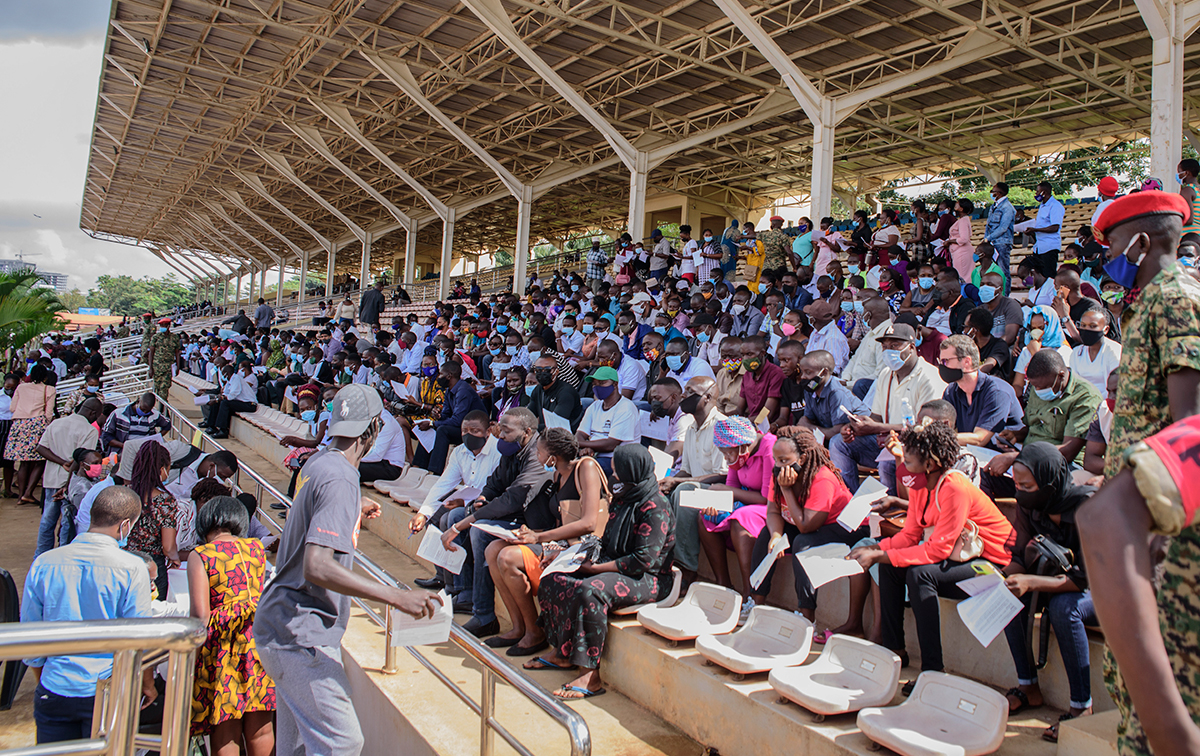
There is a glaring disparity in vaccination rates around the world. More than 48% of adults in the U.S. have been fully vaccinated, according to the New York Times, but only about 1% of Africans have been fully vaccinated. Here in Kampala, Uganda, people wait to be vaccinated, May 10. Photo: AP
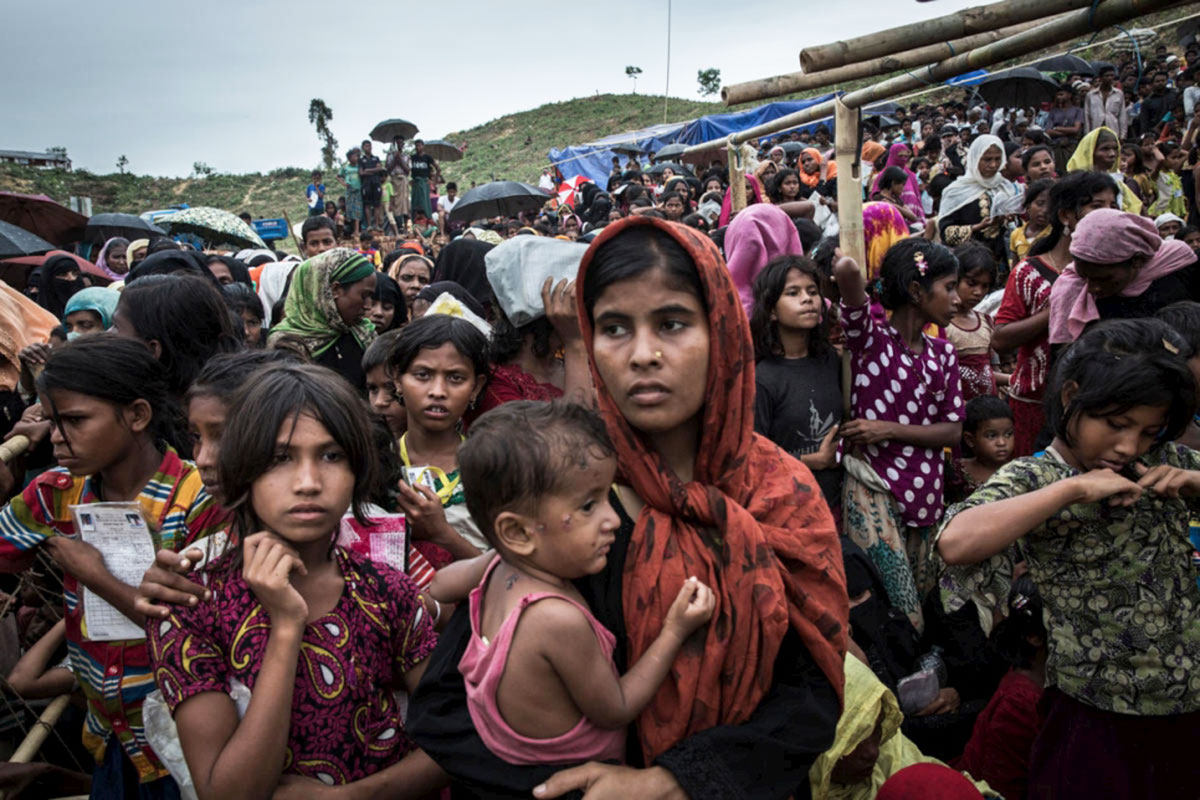
People whose traditional livelihood was ruined from poverty, war, violence, and/or ecological calamity flee to cities. Here, some of the 3.5 million refugees in Myanmar, who face food insecurity. (Photo: UNCHR)
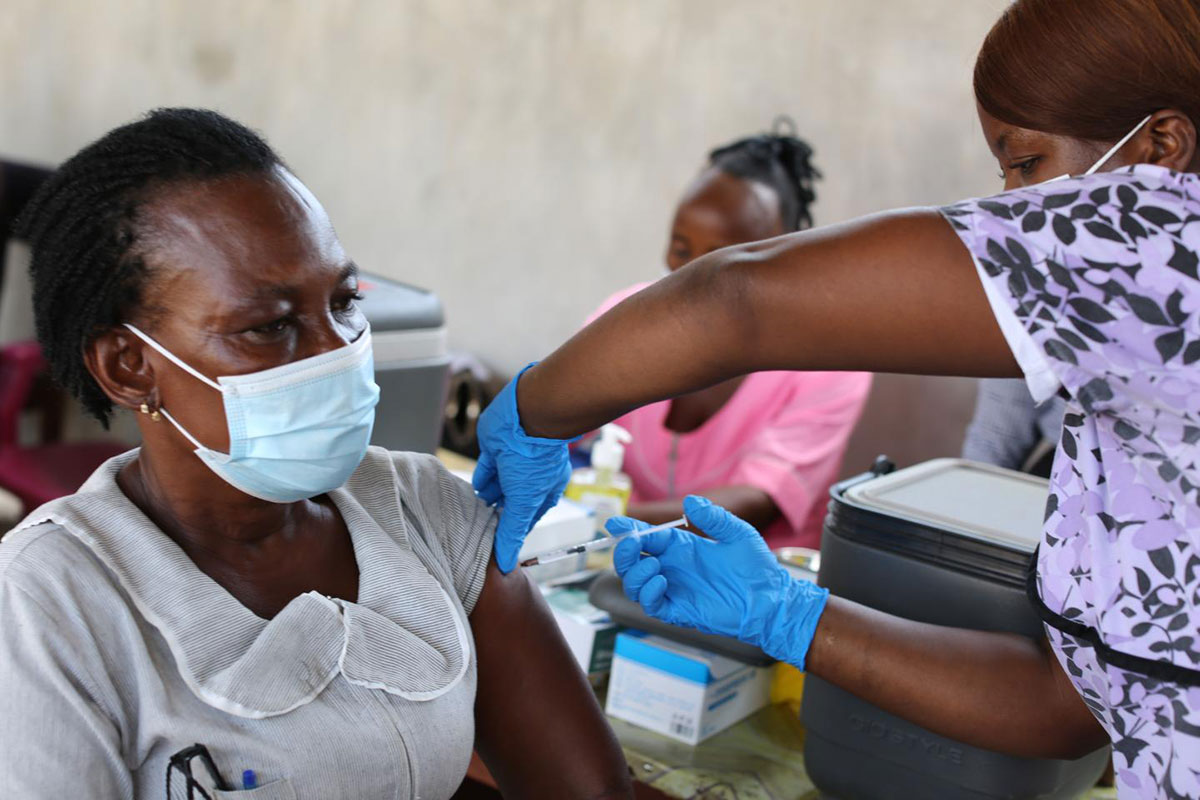
The U.S. government has a surplus a vaccines and begs people to get vaccinated while Sierra Leone’s vaccination rate just reached 1% on June 20. Photo: UNICEF
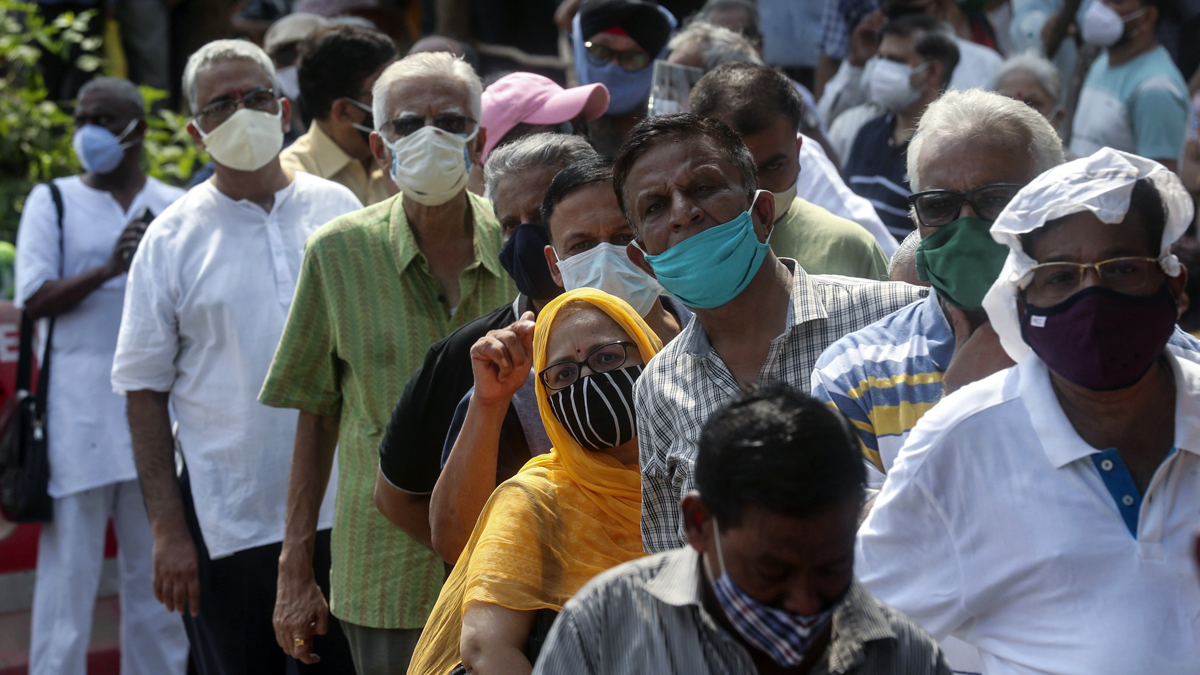
One-half of all vaccine doses have gone to wealthy countries, which make up only 19% of the world’s population. Here, people in India line up for vaccine during a surge in cases and. deaths, April 2021. Photo: AP
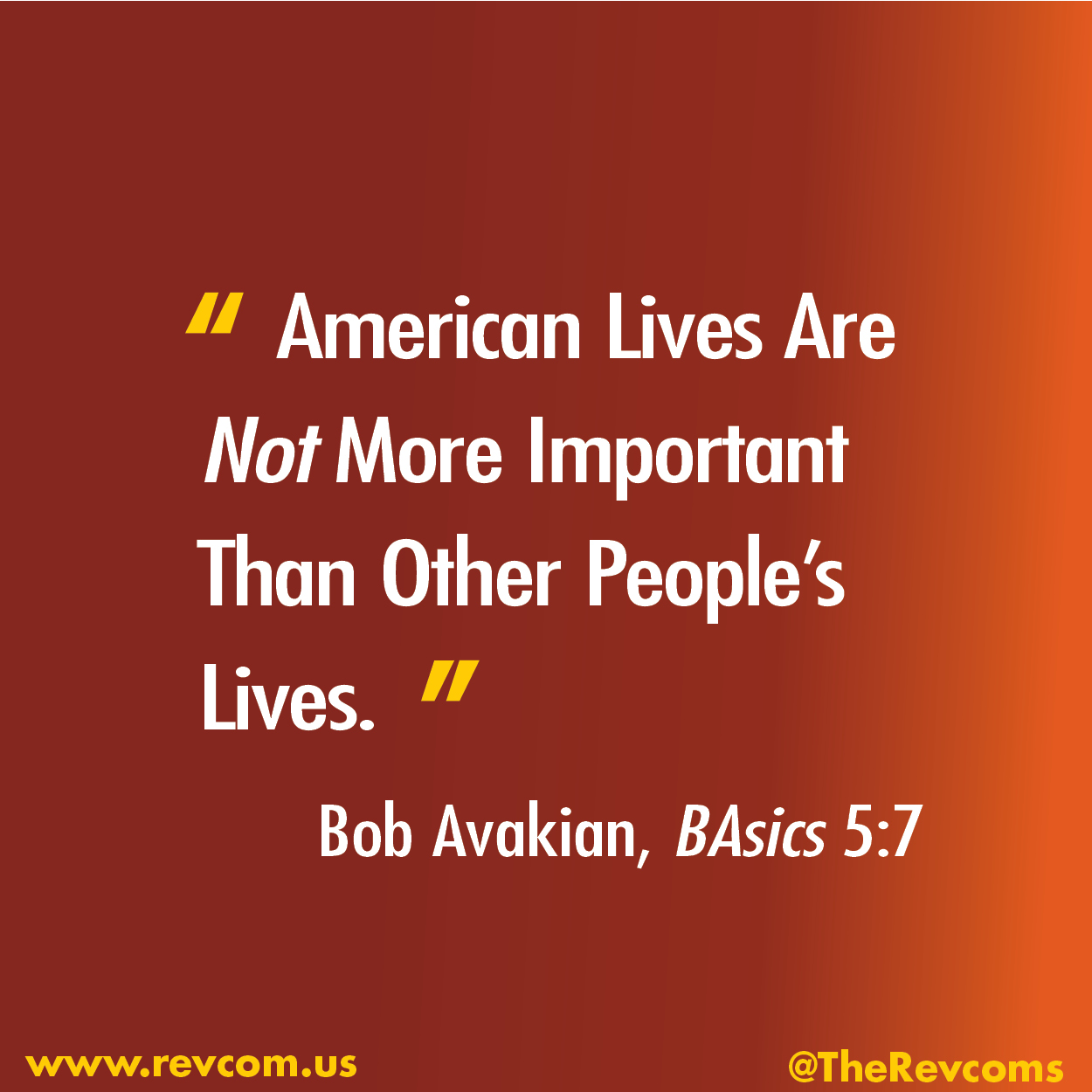
Get a free email subscription to revcom.us:


